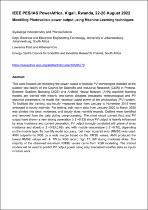JavaScript is disabled for your browser. Some features of this site may not work without it.
- ResearchSpace
- →
- Research Publications/Outputs
- →
- Journal Articles
- →
- View Item
| dc.contributor.author |
May, Siyasanga I

|
|
| dc.contributor.author |
Pratt, Lawrence E

|
|
| dc.contributor.author |
Roro, Kittessa T

|
|
| dc.contributor.author |
Bokoro, P

|
|
| dc.date.accessioned | 2023-04-04T10:13:00Z | |
| dc.date.available | 2023-04-04T10:13:00Z | |
| dc.date.issued | 2022-08 | |
| dc.identifier.citation | May, S.I., Pratt, L.E., Roro, K.T. & Bokoro, P. 2022. Modelling photovoltaic power output using machine Learning techniques. http://hdl.handle.net/10204/12713 . | en_ZA |
| dc.identifier.isbn | 978-1-6654-6639-4 | |
| dc.identifier.isbn | 978-1-6654-6638-7 | |
| dc.identifier.isbn | 978-1-6654-6640-0 | |
| dc.identifier.uri | DOI: 10.1109/PowerAfrica53997.2022.9905279 | |
| dc.identifier.uri | http://hdl.handle.net/10204/12713 | |
| dc.description.abstract | This work focuses on modelling the power output of multiple PV technologies installed at the outdoor test facility of the Council for Scientific and Industrial Research (CSIR) in Pretoria. Extreme Gradient Boosting (XGB) and Artificial Neural Network (ANN) machine learning models are trained with historic time-series datasets (measured meteorological and PV electrical parameters) to model the historical output power of the photovoltaic (PV) system. To facilitate the training, sub-hourly measured data from January to November 2019 were averaged at hourly intervals. For testing, sub-hourly data from January 2020 to March 2020 was divided into clear, moderate, and cloudy skies monthly records. Outliers were identified and removed from the data during pre-processing. The short circuit current (Isc) and PV output have shown a very strong correlation (r 2 =0.93) since PV output is heavily influenced by array irradiance and current generation. PV output strongly correlated with plane of array irradiance and albedo (r 2 =0.83,0.69), and with module temperature (r 2 =0.70), depending on the module type. To quantify model accuracy, root mean squared error (RMSE) was used. ANN outperforms XGB by a wide margin based on the RMSE values. ANN produced the lowest RMSE values with 4. 1W to XGB record high 17. 5W during moderate skies. The majority of the observed maximum RMSE values came from XGB modelling. The trained models will be used to predict PV output power using only forecasted weather data as inputs in future work. | en_US |
| dc.format | Abstract | en_US |
| dc.language.iso | en | en_US |
| dc.relation.uri | https://ieeexplore.ieee.org/abstract/document/9905279 | en_US |
| dc.source | IEEE PES/IAS PowerAfrica, Kigali, Rwanda, 22-26 August 2022 | en_US |
| dc.subject | Artificial neural networks | en_US |
| dc.subject | Extreme Gradient Boosting | en_US |
| dc.subject | Artificial Intelligence | en_US |
| dc.subject | Photovoltaic | en_US |
| dc.title | Modelling photovoltaic power output using machine Learning techniques | en_US |
| dc.type | Conference Presentation | en_US |
| dc.description.pages | 5pp | en_US |
| dc.description.note | ©2022 IEEE. Due to copyright restrictions, the attached PDF file only contains the abstract of the full text item. For access to the full text item, please consult the publisher's website: https://ieeexplore.ieee.org/abstract/document/9905279 | en_US |
| dc.description.cluster | Smart Places | en_US |
| dc.description.impactarea | Energy Supply and Demand | en_US |
| dc.identifier.apacitation | May, S. I., Pratt, L. E., Roro, K. T., & Bokoro, P. (2022). Modelling photovoltaic power output using machine Learning techniques. http://hdl.handle.net/10204/12713 | en_ZA |
| dc.identifier.chicagocitation | May, Siyasanga I, Lawrence E Pratt, Kittessa T Roro, and P Bokoro. "Modelling photovoltaic power output using machine Learning techniques." <i>IEEE PES/IAS PowerAfrica, Kigali, Rwanda, 22-26 August 2022</i> (2022): http://hdl.handle.net/10204/12713 | en_ZA |
| dc.identifier.vancouvercitation | May SI, Pratt LE, Roro KT, Bokoro P, Modelling photovoltaic power output using machine Learning techniques; 2022. http://hdl.handle.net/10204/12713 . | en_ZA |
| dc.identifier.ris | TY - Conference Presentation AU - May, Siyasanga I AU - Pratt, Lawrence E AU - Roro, Kittessa T AU - Bokoro, P AB - This work focuses on modelling the power output of multiple PV technologies installed at the outdoor test facility of the Council for Scientific and Industrial Research (CSIR) in Pretoria. Extreme Gradient Boosting (XGB) and Artificial Neural Network (ANN) machine learning models are trained with historic time-series datasets (measured meteorological and PV electrical parameters) to model the historical output power of the photovoltaic (PV) system. To facilitate the training, sub-hourly measured data from January to November 2019 were averaged at hourly intervals. For testing, sub-hourly data from January 2020 to March 2020 was divided into clear, moderate, and cloudy skies monthly records. Outliers were identified and removed from the data during pre-processing. The short circuit current (Isc) and PV output have shown a very strong correlation (r 2 =0.93) since PV output is heavily influenced by array irradiance and current generation. PV output strongly correlated with plane of array irradiance and albedo (r 2 =0.83,0.69), and with module temperature (r 2 =0.70), depending on the module type. To quantify model accuracy, root mean squared error (RMSE) was used. ANN outperforms XGB by a wide margin based on the RMSE values. ANN produced the lowest RMSE values with 4. 1W to XGB record high 17. 5W during moderate skies. The majority of the observed maximum RMSE values came from XGB modelling. The trained models will be used to predict PV output power using only forecasted weather data as inputs in future work. DA - 2022-08 DB - ResearchSpace DP - CSIR J1 - IEEE PES/IAS PowerAfrica, Kigali, Rwanda, 22-26 August 2022 KW - Artificial neural networks KW - Extreme Gradient Boosting KW - Artificial Intelligence KW - Photovoltaic LK - https://researchspace.csir.co.za PY - 2022 SM - 978-1-6654-6639-4 SM - 978-1-6654-6638-7 SM - 978-1-6654-6640-0 T1 - Modelling photovoltaic power output using machine Learning techniques TI - Modelling photovoltaic power output using machine Learning techniques UR - http://hdl.handle.net/10204/12713 ER - | en_ZA |
| dc.identifier.worklist | 26334 | en_US |






